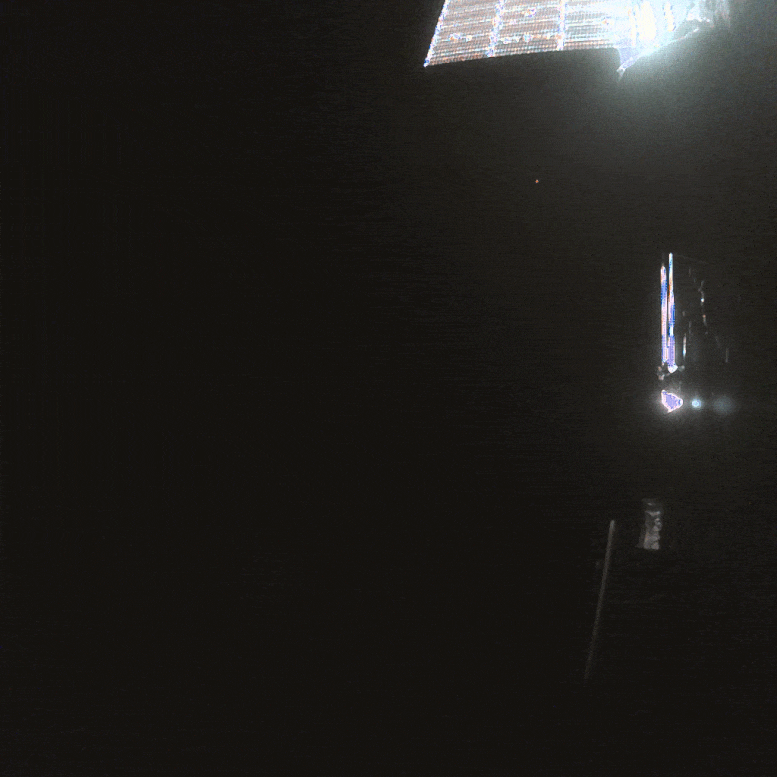ESA’s Juice spacecraft captured its first monitoring camera images after a successful launch on April 14. The cameras will record various deployments, including the Radar for Icy Moons Exploration antenna, while a scientific camera will capture high-resolution images of Jupiter and its icy moons in 2031.
ESA’s Jupiter Icy Moons Explorer (Juice) has taken its first monitoring camera images showing part of the spacecraft with Earth as a stunning backdrop.
Shortly after launch on April 14, ESA’s Jupiter Icy Moons Explorer, Juice, captured this stunning view of Earth. The image was taken by Juice monitoring camera 1 (JMC1) at 14:18 CEST, following launch at 14:14 CEST. JMC1 is located on the front of the spacecraft and looks diagonally up into a field of view that will eventually see deployed antennas, and depending on their orientation, part of one of the solar arrays. Credit: ESA/Juice/JCAM, CC BY-SA 3.0 IGO
The mission launched on an Ariane 5 from Europe’s Spaceport in Kourou on April 14, (8:14 a.m. EDT / 14:14 CEST) and the images were captured in the hours afterward.
Shortly after launch on April 14, ESA’s Jupiter Icy Moons Explorer, Juice, captured this stunning view of Earth. The coastline around the Gulf of Aden can be made out to the right of center, with patchy clouds above land and sea. The image was taken by Juice monitoring camera 1 (JMC1) at 14:38 CEST, following launch at 14:14 CEST. JMC1 is located on the front of the spacecraft and looks diagonally up into a field of view that will eventually see deployed antennas, and depending on their orientation, part of one of the solar arrays. Credit: ESA/Juice/JCAM, CC BY-SA 3.0 IGO
Juice has two monitoring cameras located on the ‘body’ of the spacecraft to record various deployments. The images provide 1024 x 1024 pixel snapshots. The images shown here are lightly processed with a preliminary color adjustment.
A scientific camera will be used for taking high-resolution images of Jupiter and its icy moons once in the Jovian system in 2031.
This pair of images captures the rotation of the Jupiter Icy Moons Explorer’s solar arrays during their deployment after launch on April 14.
The images were taken by Juice monitoring camera 1 (JMC1), which is located on the front of the spacecraft and looks diagonally up into a field of view that will eventually see deployed antennas, and depending on their orientation, part of one of the solar arrays. Because of the acute viewing angle of the camera, only part of the array is seen, in this case part of the distinctive cross-shape pattern of one of the solar panels.
The first image was taken at 15:28 CEST during solar array panel deployment. The second image was taken at 15:32 CEST, and shows the panels having rotated into their 70 degree position, just a few seconds before the deployment sequence was confirmed to have completed.
The lighting conditions are challenging in this scene, with the side of the array causing a bright reflection.
Each of the two ‘wings’ comprise five 2.5 x 3.5 m panels with a total area of 85 square meters. In total they span 27 m tip-to-tip, and are crucial to provide the necessary power to run the spacecraft and operate the science instruments once exploring the Jupiter system, where sunlight is 25 times weaker than on Earth. Their deployment, completed at 15:33 CEST, was critical to the success of the mission.
Credit: ESA/Juice/JCAM, CC BY-SA 3.0 IGO
Juice monitoring camera 1 (JMC1) is located on the front of the spacecraft and looks diagonally up into a field of view that sees a part of one of the solar arrays, and will eventually see deployed antennas.
Juice monitoring camera 2 (JMC2) is located on the top of the spacecraft and is placed to monitor the multi-stage deployment of the 16 m-long Radar for Icy Moons Exploration (RIME) antenna. RIME is an ice-penetrating radar that will be used to remotely probe the subsurface structure of the large moons of Jupiter.
Shortly after launch on April 14, ESA’s Jupiter Icy Moons Explorer, Juice, captured this image with its Juice monitoring camera 2 (JMC2).
JMC2 is located on the top of the spacecraft and is placed to monitor the multi-stage deployment of the 16 m-long Radar for Icy Moons Exploration (RIME) antenna. RIME is an ice-penetrating radar that will be used to remotely probe the subsurface structure of the large moons of Jupiter.
In this image, RIME is seen in stowed configuration. It will be deployed in stages over the coming days.
The image was taken at 14:16 CEST, just two minutes after launch.
Credit: ESA/Juice/JCAM, CC BY-SA 3.0 IGO
RIME is currently in stowed configuration; it will unfold in stages over the coming days. Images will be taken to capture the full deployment.
The monitoring cameras will also be active during various mission operations, including gravity-assist flybys of the Moon, Earth, and Venus during the cruise to Jupiter.
About Juice
Juice represents humanity’s daring venture into the outer reaches of our Solar System. After an eight-year odyssey to Jupiter, the spacecraft will closely examine the gas giant and its trio of large, ocean-harboring moons: Ganymede, Callisto, and Europa. This enterprising mission will employ an array of remote sensing, geophysical, and in situ instruments to unravel the mysteries of these intriguing celestial bodies as potential abodes for past or present life. Delving into Jupiter’s intricate magnetic, radiation, and plasma environment, Juice will investigate the planet’s interactions with its moons, using the Jupiter system as a model for gas giant systems throughout the cosmos.
Source: scitechdaily.com












